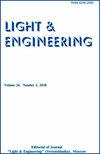The Effects of Luminaire Glass Type on Road Parameters in Road Lighting
IF 0.3
4区 工程技术
Q4 ENGINEERING, ELECTRICAL & ELECTRONIC
引用次数: 0
Abstract
The aim of this study is to draw attention to the light transmittance level of special glasses with low light transmission. Although it is known that the light transmittance of these special glasses is low, this study is important in terms of knowing the light transmission rate in question and what kind of light problems it causes in practice, because these special glasses can be used for road lighting in some special climatic conditions, for some experiments, or for the use of light in architectural designs. For this reason, it is important to know these special glasses light transmittance properties. As the light transmittance of the luminaire glasses increases, the amount of light on the road also increases. In other words, the light source or glass type affects the lighting performance of the road. The luminaire affects the light emitted from glass-type luminaires and reduces the luminous flux falling from the lamp to the road surface. For this reason, the lamp’s luminous flux with the appropriate power should be increased according to the light transmittance factor of the glasses. Otherwise, the conditions, specified in the CIE road lighting standards, cannot be met. For this purpose, luminaire glasses with different properties that can be used in road lighting were analysed according to their light transmittance of single glass (4 mm), double glass (4 mm), electrochromic glass (reflective), electrochromic glass (absorbent), and thermochromics glass. As a result, it has been determined that when the luminaires used in road lighting are without glass or the luminaire glasses are made of different materials, the lamps luminous fluxes should be increased according to the transmittance coefficient of the glasses.道路照明中灯具玻璃类型对道路参数的影响
本研究旨在引起人们对低透光率特种玻璃透光率水平的关注。虽然我们知道这些特殊玻璃的透光率很低,但这项研究对于了解所讨论的透光率以及在实践中会导致什么样的光问题是很重要的,因为这些特殊玻璃可以用于一些特殊气候条件下的道路照明,也可以用于一些实验,或者用于建筑设计中的光使用。因此,了解这些特殊玻璃的透光性是很重要的。随着灯具玻璃透光率的增加,道路上的光量也随之增加。换句话说,光源或玻璃类型影响道路的照明性能。该灯具影响玻璃型灯具发出的光,减少从灯具落到路面的光通量。因此,应根据眼镜的透光系数,增加适当功率的灯的光通量。否则,将不能满足CIE道路照明标准中规定的条件。为此,根据单玻璃(4mm)、双玻璃(4mm)、电致变色玻璃(反射)、电致变色玻璃(吸收)和热致变色玻璃的透光率,分析了可用于道路照明的不同性能的灯具玻璃。因此,确定了道路照明使用的灯具在不使用玻璃或灯具玻璃材质不同时,应根据玻璃的透光系数提高灯具光通量。
本文章由计算机程序翻译,如有差异,请以英文原文为准。
求助全文
约1分钟内获得全文
求助全文
来源期刊

Light & Engineering
ENGINEERING, ELECTRICAL & ELECTRONIC-OPTICS
CiteScore
1.00
自引率
50.00%
发文量
0
审稿时长
1 months
期刊介绍:
Our magazine
develops comprehensive communication within the lighting community, providing opportunities for discussion and free expression of opinions of specialists of different profiles;
contributes to the convergence of science and engineering practice, the search for opportunities for the application of research results in lighting and technological applications of light;
keeps the scientific community up to date with the latest advances in the theory of the light field, providing readers with operational professional information;
initiates international cooperation, promotes and distributes the results of Russian authors in the international professional community;
provides equal opportunities for authors from different regions of Russia and other countries.
The journal publishes articles in the following areas:
visual and non-visual effects of radiation on humans;
light field theory;
photometry and colorimetry;
sources of light;
ballasts;
light devices, their design and production technology;
lighting and irradiation installation;
light signaling;
methods of mathematical modeling of light devices and installations;
problems of energy saving in lighting, installation and operation of lighting installations;
modern production technologies of lighting products for lighting control systems;
innovative design solutions;
innovations in lighting and lighting design;
the study of the effect on plants and animals, problems of using light in medicine;
problems of disinfection of premises, water and smell elimination with the help of technology of UV radiation using;
problems of light in the ocean and space.
 求助内容:
求助内容: 应助结果提醒方式:
应助结果提醒方式:


